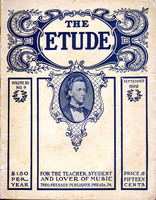The occasional use of the organ, without pedals, has been touched upon in this department. This matter is of considerable importance. All works on organ-playing—and, in particular, on organ accompaniment—give many practical and useful suggestions in this direction, which appear, however, to be generally more honored in the breach than in the observance.
Orchestral writing furnishes us with a good parallel, offering many valuable hints which might readily be adopted in the treatment of organ registration, both in accompaniment and solo-work.
The use of the 16-feet pedal of the organ is analogous to that of the double bass in the orchestra. The continued use of either, without occasional cessation, grows extremely monotonous. All orchestral writers are keenly alive to this fact, and score accordingly. Organists, however, both composers and executants, appear somewhat careless in the matter.
The main reason for the apparent unpopularity of the use of the organ without pedals probably lies in the fact that some organists have never given the device a fair trial and have not studied its capabilities. It is by no means sufficient—in hymn-playing, for instance—simply to drop the use of the pedals occasionally, continuing with the same manual combination. The effects must be studied, and, in this, orchestral treatment furnishes us with many object-lessons.
One of the most common devices, for instance, is the use of the strings (minus the double basses) in four-part harmony, occasionally perhaps reinforced by the wood-wind or horns. This might be exactly paralleled in organ-accompaniment by the use of 8-feet stops of stringy tone, occasionally adding soft 8-feet flutes, or even for coloring a soft 4-feet flute. How many organists would refrain from the use of the pedal with this or similar combinations?
There are instances when the foundation stops are of solid quality and 4-feet and perhaps 2-feet stops are used, in which the 16-feet manual stops may be added, still omitting the pedals. This is a true organ- effect, but it cannot be used in some modern organs where the builders, in search of solo and other novelties, have so skimped both foundation and 16-feet stops as to cause the “grand chorus” to sound like a bad—a very bad—brass band.
In the accompaniment of solos and other numbers, originally with orchestral accompaniment, the organist should seek, so far as possible, to carry out the design of the composer. This will often cause a temporary disuse of the pedals in many passages and a very sparing use in others. This whole matter is worthy of attention, and will repay careful study.—Preston Ware Orem.



